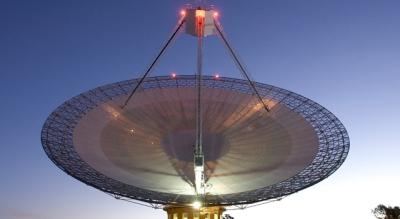Mon, Jul 15, 2013
Possible Sources Include Merging Or Exploding Stars
Astronomers have detected the first population of radio bursts known to originate from galaxies beyond our own Milky Way. The sources of the light bursts are unknown, but cataclysmic events, such as merging or exploding stars, are likely the triggers. A radio burst is a quick surge of light from a point on the sky, made up of longer wavelengths in the radio portion of the light spectrum. A single radio burst was detected about six years ago, but researchers were unclear about whether it came from within or beyond our galaxy.

The new radio-burst detections -- four in total -- are from billions of light-years away, erasing any doubt that the phenomenon is real. The discovery, described in the July 4 issue of the journal Science, comes from an international team that used the Parkes Observatory in Australia. "Short radio bursts are really tricky to identify," explained Sarah Burke Spolaor of NASA's JPL. "Our team had to search 11 months of data covering a large sky area to find them."
Spolaor developed the software used to seek single pulses in the radio data and pick out genuine signals from local interference sources -- such as cell phones, spark plugs and aircraft. This amounted to an enormous and complex computational task. Dan Thornton, lead author of the new study from England's University of Manchester and Australia's Commonwealth Scientific and Industrial Research Organization, said, "The radio bursts last for just a few milliseconds and the farthest one that we detected was 11 billion light-years away."
The findings open the door to studying an entirely new class of eruptive cosmic events and can also help with cosmology mysteries, for example, about the nature of matter in the universe.
Our sky is full of flares and bursts of varying natures. For instance, gamma-ray bursts are thought to occur when stars collapse into black holes. They are routinely detected by a network of telescopes on the ground and in space, including NASA's Swift and Fermi. When one telescope in the network detects a burst, it can notify others to quickly slew to the target for coordinated observations. The newfound radio bursts, while likely of a different origin than gamma-ray bursts, also consist of light waves generated by powerful events happening at great distances. Researchers would like to develop systems similar to the gamma-ray burst networks of telescopes to follow up quickly on radio bursts, but this is more challenging because radio waves are slowed by gas in space. Time is needed to process the radio observations and tease out the short-lived bursts.
On the other hand, the fact that radio waves are impeded as they travel through space to reach us offers benefits. By studying how the radio waves have been slowed, scientists can better understand baryonic matter, the material that gets in the way. Baryonic matter is what makes up people and planets and everything you see. The rest of the universe consists of mysterious substances called dark matter and dark energy.
Exactly what is triggering the release of the radio waves is unknown. Theories include colliding neutron stars or black holes; evaporating black holes; and stellar explosions called supernovae. The new data do not fit nicely with any of these scenarios, leaving the scientists perplexed.
Further scans for radio bursts using the Parkes Observatory are ongoing. Researchers are also using other telescopes to search for and characterize these events. For instance, the V-Fastr project, developed in part at JPL, is currently running on the National Radio Astronomy Observatory's Very Long Baseline Array, an international network of telescopes. It will enable scientists to localize a burst's origin to a precise location in a distant host galaxy.
(Image provided by JPL.)
More News
Aero Linx: International Business Aviation Council Ltd IBAC promotes the growth of business aviation, benefiting all sectors of the industry and all regions of the world. As a non->[...]
"During the annual inspection of the B-24 “Diamond Lil” this off-season, we made the determination that 'Lil' needs some new feathers. Due to weathering, the cloth-cove>[...]
Also: Bushcat Woes, Hummingbird 300 SL 4-Seat Heli Kit, Carbon Cub UL The newest Junkers is a faithful recreation that mates a 7-cylinder Verner radial engine to the airframe offer>[...]
Also: Seaplane Pilots Association, Rotax 916’s First Year, Gene Conrad After a decade and a half of struggling with the FAA and other aero-politics, G100UL is in production a>[...]
Also: Martha King Scholarship, Montaer Grows, Textron Updates Pistons, FlySto The FAA is hiring thousands of air traffic controllers, but the window to apply will only be open for >[...]
 ANN's Daily Aero-Linx (04.16.24)
ANN's Daily Aero-Linx (04.16.24) Aero-News: Quote of the Day (04.16.24)
Aero-News: Quote of the Day (04.16.24) Airborne 04.10.24: SnF24!, A50 Heritage Reveal, HeliCycle!, Montaer MC-01
Airborne 04.10.24: SnF24!, A50 Heritage Reveal, HeliCycle!, Montaer MC-01 Airborne 04.12.24: SnF24!, G100UL Is Here, Holy Micro, Plane Tags
Airborne 04.12.24: SnF24!, G100UL Is Here, Holy Micro, Plane Tags Airborne-Flight Training 04.17.24: Feds Need Controllers, Spirit Delay, Redbird
Airborne-Flight Training 04.17.24: Feds Need Controllers, Spirit Delay, Redbird



